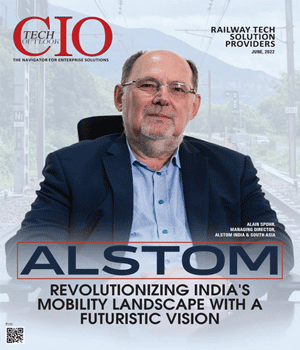
Enabling an Automotive Strategy Compliant to Cloud Computing
David Decker, CIO and VP IT, Johnson Controls Automotive Seating | Thursday, 16 June 2016, 08:55 IST
 Cloud computing is driving profound changes in the role of the CIO. Traditionally, CIOs were responsible for the day-to-day activities encompassing the entire lifecycle of information technology systems, including development, implementation, hosting, maintenance and renewal. Enabled in large part by the proliferation of cloud computing, our role is now migrating to that of a technical strategist who identifies and selects partners to help deliver information technology services to the business. However, it is important to take a thoughtful and measured approach toward migrating to the cloud. This is especially true in the automotive industry, where tight IT budgets and requirements for extremely high availability may rule out cloud applications in certain areas. Both the business and IT should carefully consider where not to migrate to the cloud.
Cloud computing is driving profound changes in the role of the CIO. Traditionally, CIOs were responsible for the day-to-day activities encompassing the entire lifecycle of information technology systems, including development, implementation, hosting, maintenance and renewal. Enabled in large part by the proliferation of cloud computing, our role is now migrating to that of a technical strategist who identifies and selects partners to help deliver information technology services to the business. However, it is important to take a thoughtful and measured approach toward migrating to the cloud. This is especially true in the automotive industry, where tight IT budgets and requirements for extremely high availability may rule out cloud applications in certain areas. Both the business and IT should carefully consider where not to migrate to the cloud.
“Even more than in the past, automotive suppliers are being asked by their OEM customers to drive down costs”
Even more than in the past, automotive suppliers are being asked by their OEM customers to drive down costs. Margins are continually squeezed and, as a result, budgets for new IT projects are carefully scrutinized. Automotive suppliers typically spend 1-3 percent of revenue on IT. At Johnson Controls, we carefully prioritize our IT work to ensure we spend the allocated budget on only the projects with the highest returns.
While cloud computing has been around for years, the term became increasingly popular and CIOs really began to take notice of it in the late 2000s. This was true at Johnson Controls as well. The IT leadership team spent a week in Seattle and Silicon Valley meeting with Microsoft, HP and others to learn everything we could about the benefits and risks of cloud computing. We came back with a significantly more informed view of where Johnson Controls can most benefit from cloud computing, and, perhaps more importantly, where we should stay away. This helped me put together our Automotive IT strategy in relation to cloud computing.
In our Automotive Seating Business Unit, we have taken a measured and practical approach to the cloud. Our IT dollars are focused on helping us produce the highest quality automotive seats and seating components at the lowest possible cost. We ship our products, in particular our seats, just-in-time to our OEM customers. To keep costs down, we strive to limit our inventory and therefore assemble our seats just-in-time as well. From the time we receive the broadcast information from our customer’s assembly plant, we typically have only a three- to four-hour window in which to assemble and ship. Therefore it is absolutely critical that all our systems have six-sigma levels of uptime. For this reason we have adopted a strategy of ensuring each plant can continue running, uninterrupted, in the event of a wide-area network outage. And it is for this reason that we are presently avoiding cloud-based computing for our Manufacturing Execution Systems, which provide real-time control and analytics for production of our seats and seating components.
Where we do see value, however, and where we are pursuing cloud computing is around employee and productivity systems. In another manufacturing example, our Human Resource business partners came to us to help them resolve a number of issues with a legacy timekeeping system across our JIT seating plants in North America. These were basically stand-alone systems located in each plant, each instance of which required its own server, licensing, maintenance, upgrades, etc. When we took a look at our options, it was an obvious choice to implement the latest cloud-based version of this application. Aside from replacing time clocks in each of the plants, nothing was installed in our manufacturing facilities and all software was in the cloud. Deployment costs and timing were reduced significantly. Not only did we retire 40 servers across the plants, and benefit from the reduced maintenance costs, we avoided spending capital on the associated hardware upgrades. This system has been considered a success for Human Resources and for IT, and I refer to it as our “quietest launch ever.”
Another example is our migration to Microsoft Outlook. When Johnson Controls decided to move to a new email and office productivity suite, we debated on-premise vs. cloud. After reviewing the Office 365 product in depth, that’s what we chose. Implementation was significantly easier, as we shifted the burden of hosting, security and managing upgrades to Microsoft. Similarly, when we looked at upgrading our Human Resources management system a few years ago, we chose the cloud-based subscription service from Workday. Once again, this greatly simplified our deployment, and in both cases, new releases are practically a non-event.
While industry trade journals and many consultants and vendors are advocating a no-holds barred rush to the cloud, practical CIOs in manufacturing should take a thoughtful and measured approach, considering not only their limited IT budgets, but their business partners’ and customers’ appetites for risk. This will help ensure they remain relevant by adopting cloud computing where it makes the most sense, and by avoiding it where it will put their company, and their customers, at risk.
CIO Viewpoint
The Changing Dynamics of Automotive Industry
By CIOReview India Team
The Transition To Cloud Technology
By T.G. Dhandapani, Ex-CIO, TVS Motor
Making Better Informed Management Decisions
By Ravishankar N, CTO, Spectranet
CXO Insights
Tech Landscape of In-Cabin Experiences and...
By Sanjay Saha, India Country Manager, Synaptics
3 Focus Areas For An Autonomous Driving Revolution
By Varun Chhabra, Vice President, Product Marketing Cloud, Dell Technologies
The Electrified Car Industry Must Reimagine its...





.jpg)
.jpg)
.jpg)





